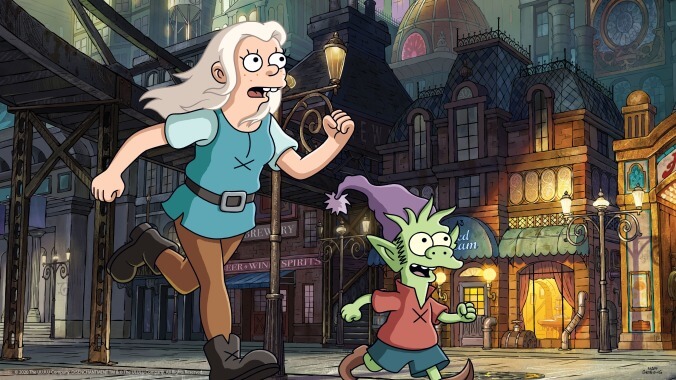Disenchantment gets bogged down in plot and loses sight of jokes in “Part 3”

When we last left Disenchantment, our heroes—Princess Bean (Abbi Jacobson), Elfo (Nat Faxon), and Luci (Eric Andre)—were about to be burned at the stake by the impulsive, superstition-inclined Dreamland populace. Fortunately, at the last moment, they fell through the ground and landed in a catacomb populated by Trogs, a bug-eyed subterranean community under the rule of Dagmar (Sharon Horgan), Bean’s mother, who’s still trying to manipulate her daughter to fulfill her mysterious destiny. We pick up as Bean and her two comrades try to get back above ground; meanwhile, on the surface, Odval (Maurice LaMarche) and the Druidess (Tress MacNeille) continue their plot to take over Dreamland as King Zøg (John DiMaggio) recovers from his gunshot wound. When Zøg discovers their scheme and plans to re-take control, Odval and the Druidess decide to bury him alive and rid the kingdom of their enemies forever.
Little do they know that no one in Dreamland stays dead for very long, because Disenchantment’s internal logic regarding mortality, as well as the lines between medieval fantasy and other genres, remains as flexible as ever. (“I mean, people get turned to stone or burned alive, and the next thing you know, they’re walking around, no harm, no foul,” one Dreamland citizen complains before being shot in the chest with a flaming arrow.) Disenchantment’s prior commitment to maintaining the status quo—i.e., Bean and pals in Dreamland facing enemies within and beyond the kingdom walls—was enough to ensure that the series didn’t become too immersed in its own mythology, which spans multiple lands and involves numerous adversaries with ever-shifting motivations. Similarly, the series previously balanced standalone adventures against its main serialized narrative to ensure that the plot’s complexities don’t overwhelm the humor. Disenchantment tends to excel when it focuses on jokes. Generally speaking, sight gags, one-liners, and puns tend to linger in the mind longer than the particulars of various narrative strands, especially for a comedy.
Unfortunately, part one of Disenchantment’s second season (also known as “part three”) doubles down on the plot and strays further away from its comedic core. This season, Bean and Elfo (and sometimes Luci) spend relatively little time in Dreamland because they’re constantly being whisked to other lands or trying to safely return from them. This wouldn’t be a problem if these escapades weren’t primarily in service of propelling a byzantine narrative about how and why Dreamland is constantly under siege. It’s also likely why Disenchantment indulges in so much expository dialogue this season—a necessity to keep viewers abreast of the myriad conflicts. Plus, Disenchantment constantly splits up its main trio, either to sideline them in the case of Luci, or isolate them ostensibly to deepen their individual characterizations. However, much of that time is spent introducing new characters to illuminate old ones, and only a couple, like eager industrialist Alva (Richard Ayoade) and sarcastic mermaid Mora (Meredith Hagner), are interesting enough to warrant such a choice. Similarly, the series frequently digresses to explore other less interesting characters, like Bean’s Ralph Wiggum-esque half-brother Derek (MacNeille) who hits puberty while walking through an enchanted forest. In an attempt to build out the world and the rest of the bloated ensemble, Disenchantment not only shortchanges its heroes but also loses sight of what made the series modestly fun in the first place.
It’s even more dispiriting considering the too-brief moments when Disenchantment locks into gear. A two-episode return to Steamland gives the animators room to flex their muscles in a different aesthetic, like rampant mechanistic imagery and the region’s urban verticality. More importantly, the jokes ratchet up a notch as well, and include such delightful absurdities like an “educational” carnival ride that explains Steamland’s ridiculous origins, which involve a dead monk. (At one point, the ride’s voiceover confidently proclaims, “Steam! The warm, damp touch of modern life!”) It’s a potent reminder of what Disenchantment looks like when it focuses on gags instead of religiously committing to story. Alas, Bean and Elfo only voyage to Steamland in search of a traitor and leave to forgo an alliance, and once they move on, the series does as well, which irritates only because of how much time Disenchantment spends on the old conflict in the new world. It would be less of an annoyance if comedy was the main reason for such setting changes instead of setting up elements that may or may not pay off down the line.
Disenchantment’s part three will likely whet the appetites of anyone already invested in the series’ mythology or its mysteries. The 10 episodes feature plenty of callbacks to previous adventures and the return of many minor characters, which would be more amusing if they were memorable enough to have any impact. (Again, the funniest ones, like Old Man Touchy, tend to be more indelible.) But for anyone who tuned in because of the potential for it to be a gag-forward, fantasy counterpart to Futurama—a show that appropriately balanced its lore-heavy narrative and litany of inside jokes with plenty of straight-ahead amusement—will be disappointed. Disenchantment gets lost in its thicket of mythos and intrigue and forgets to come up for air.